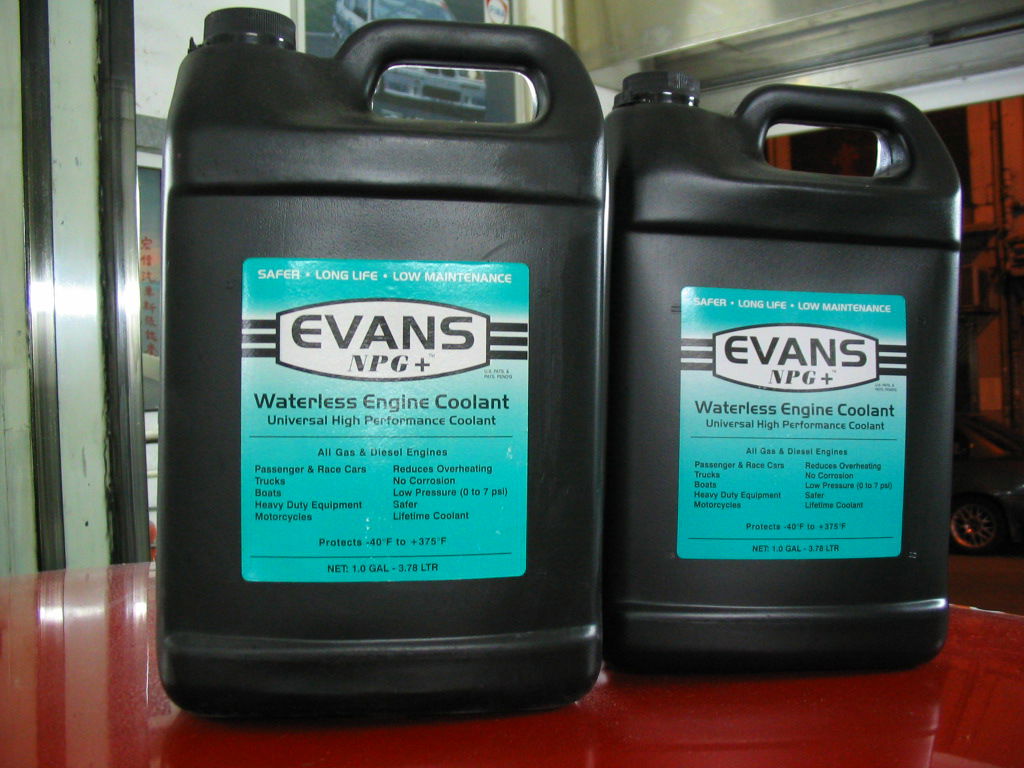| Model: | VT-0001-NPG+ |
|---|---|
| Brand: | EVANS NPG+ |
| Origin: | - |
| Category: | Transportation / Car Parts & Components |
| Label: | Engine Coolant , Water , Part |
| Price: |
¥670
/ pc
|
| Min. Order: | 3 pc |
Product Description
NPG+ WATERLESS COOLANT ELIMINATES BOIL OVER, CORROSION AND ELECTROLYSIS
NPG+ OFFERS 'POUR IN' INSTALLATION - BETTER HEAT TRANSFER - AND STILL "SAFE!"
NPG+ is new coolant providing dramatic improvements in heat transfer and viscosity that make the new fluid a "pour-in," not requiring changes to cooling system components. Conversion to NPG+ waterless coolant from the use of conventional antifreeze and water coolant mixes, to take advantage of the benefits of non-aqueous engine cooling, is now simple to accomplish.
NPG+ waterless coolant virtually eliminates boil over in gasoline or diesel engines - the waterless coolant allows engines to tolerate running hotter, without boiling over, and allows the cooling system to run at very low or no pressure. Because there is no water in the system engines operating with NPG+ will be free from corrosion and electrolysis, and the engines will run well no matter how hard they are driven or how hot or cold the environment is.
A blend of non-aqueous ingredients, NPG+ retains all of the benefits of Evans original NPG coolant, while improving upon its thermal conductivity by about 32 percent and reducing its viscosity by about 65 percent. It is perfectly suited for the demands of any hard working engine, and there are no plumbing or pump changes needed to use this coolant.
A cooling system according to Evans technology uses a non-water-based, high boiling point coolant (over 350o) and controls the temperature of the coolant substantially below its boiling point. This is in sharp contrast to conventional water based coolant systems that operate near the boiling point of the coolant. In conventional systems, locally generated coolant vapor may not condense but rather form an insulating barrier between the coolant jacket metal and the liquid coolant, causing hot spots to develop
COMPARISON OF COOLANT
PARAMETERS
Water 50/50 EGW Evans NPG Evans NPG+
Boiling Point 121° C (250° F)
(1 atm plus 15 psig) 129° C (264° F)
(1 atm plus 15 psig) 187° C (369° F)
(1 atm plus 0 psig) 191° C (375° F)
(1 atm plus 0 psig)
Viscosity
10° C (50° F) cp 1.2 5.0 115 58
80° C (176° F) cp .37 1.0 4.5 3.7
100° C (212° F) cp .28 0.7 2.8 2.3
Density
20° C (68° F) spec grav 1.00 1.066 1.038 1.091
20° C (68° F) lbs/gal 8.32 8.87 8.64 9.08
Specific Heat
80° C (176° F) Btu/lb/°F 1.00 0.81 0.68 0.64
100° C (212° F) Btu/lb/°F 1.01 0.82 0.71 0.66
Heat of Vaporization cal/mole 9,700 9,800 12,500 12,050
Vapor Pressure
80° C (176° F) mm Hg 360 270 8 6
80° C (176° F) kPa 475 360 11 8
Surface Tension
25° C (77° F) dyn/cm 72 56 36 44
Question: What is NPG+ as compared with NPG?
Answer: NPG+ contains a non-toxic blend of glycols rather than just propylene glycol. It exhibits improved heat transfer and viscosity characteristics as compared with NPG, while retaining all of the non-aqueous operational advantages of NPG. Both products are inhibited against corrosion. NPG+ is our recommended coolant.
Question: Do I need a Zero or low pressure radiator cap with NPG+ ?
Answer: NO. You may use your standard radiator pressure cap. In fact, we recommend a 7lb cap to keep NPG+ from absorbing water from the atmosphere. Some users found they could smell coolant, again a 7lb cap eliminated the issue. NPG+ will still cool your system with industry leading efficiency. Of course if you'd like to run a low pressure or even zero pressure system, you will need to purchase a low pressure cap or modify your existing cap. Please consult our tech pages or instruction guide (or call us) before modifying your existing cap!
Question: What is the practical meaning of the improved heat transfer and viscosity characteristics of NPG+?
Answer: In most cases changes to cooling system components (pumps, radiators, pressure caps, etc.) are not necessary to use NPG+.
Question: When should NPG+ be used instead of NPG?
Answer: NPG+ is preferred to NPG in all cases except where the ingredient ethylene glycol is specifically prohibited (e.g., use at certain race tracks).
Question: Evans offers a line of radiators, pumps, thermostats, and other specialty items for use with its cooling systems. Why would I need any of these items if I use NPG+?
Answer: In most cases you would not. However, for applications requiring the optimization of the cooling system for increasing spark advance or increasing compression ratios in race cars, for example, the Evans ancillary products are appropriate. The Evans pumps, radiators, and other components improve cooling by increasing the coolant flow velocity through the engine and radiator.
Question: What are the basic DIFFERENCES between non-aqueous propylene glycol (NPG) and standard coolants?
Answer: Standard coolant is comprised of ethylene glycol and water in equal parts, each represents half of total volume. Our Non-Aqueous Propylene Glycol, NPG, as the name s ests, contains NO water.
Question: Where can I buy EVANS Products?
Answer: We have a growing dealer base where NPG+ can be purchased. You may also buy direct from EVANS using our online order form or by calling us toll free at 888-990-2665. Have a favorite speed shop or auto parts store? Ask them to carry EVANS products!
Question: Is NPG a "DRAIN AND FILL" product?
Answer: If your system already has the effective flow rates needed to run with NPG, the answer is YES. Unfortunately, most vehicles, with the possible exception of large heavy duty engines and motorcycles, need some sort of modifications to establish the necessary flow rates required for effective operation with NPG. However, in most cases NPG+ (not to be confused with our older NPG) is a drain and fill product.
Question: How much Evans Coolant will I need for my system?
Answer: While these numbers may vary slightly; Small Block engines typically require a minimum of 4 gallons while Big Block engines require at least 6 gallons.
Question: What determines the changes needed to convert to a NPG cooling system?
Answer: In general, many stock cooling systems can be quickly rendered NPG ready by the introduction of a lower pressure radiator cap and a higher flow thermostat. Additional Evans components may be required as determined by the size and horsepower of the engine, the local ambient temperature, current radiator design (tube sizing and the diameters of the inlet & outlet), coolant pump efficiency, and even driving style. Evans Cooling Systems has cooling hardware packages specifically designed for the adaptation of NPG on medium and large block Chevies.
Question: What radiator size do you recommend for use with NPG?
Answer: For systems up to 300 HP without A/C a radiator configuration with 4 rows 1/2" tube copper / brass. Systems 300 to 400 HP with A/C a radiator configuration with 2 rows 1" tube aluminum. System operating over 400 HP need a minimum of 2 rows 1.25" tube aluminum.
Question: What will the COOLANT GAUGE read when using non-aqueous propylene glycol (NPG) coolant?
Answer: The normal operating range of standard coolant (ethylene glycol and water) is 160°F to 230°F with some cooling systems able to function reasonably well up to 240°F; although as this extreme temperature level is reached, the engine will almost always operate with ever less power and response until it boils over and stalls. At approximately 330°F the coolant warning light would normally light up; a cooling system operating with the more modern needle gauge would indicate higher coolant temperatures as they developed. As NPG contains no water, coolant temperatures can rise to higher levels without a negative impact on the performance of the engine. In fact, with NPG in many cases the activation of the coolant warning light represents a false warning as NPG works very well at 330°F. Gauges may show the needle at 330°F, a temperature probably located in the red, but again, no concern is warranted with NPG coolant.
Question: Will the use of NPG increase my engine's HORSEPOWER?
Answer: With some explanation the answer is YES! Operationally detonation (pre-ignition) saps horsepower. Detonation is caused by the presence of excessive water vapor in the engine cooling jackets alongside the cylinders. And again, as NPG has no water, there is no vapor and detonation is eliminated allowing the engine to recapture improved fuel economy, emissions, and horsepower. Also, this NPG cooling flexibility allows the engine to effectively control the added heat generated by the additional power realized through the development of higher cylinder compression and/or more aggressive spark timing. Remember, more power means more heat radiated into the engine's metals and fluids. Historically, racing cars have utilized NPG coolant to effectively thermally manage their engine running with up to a 16.5 to 1 compression ratio.
Question: What impact does NPG coolant have on the power needed to run an engine COOLANT PUMPS?
Answer: The power (parasitic loss) needed to operate a coolant pump running with NPG is increased over that which is needed to drive pumps working with standard coolant. However, this parasitic loss is minimal when compared to the horsepower gains (see above). And, pumps utilizing more efficient impellers and housing designs can decrease this power loss significantly, often times bringing parity with operation on standard coolants.
Question: I have an Antique or Vintage collector car and want to utilize the non-corrosive no pressure ability of NPG, will I need to alter my system to do so?
Answer: No. Because of the low horsepower of most vintage cars, NPG can be used in most applications without modification to the existing engine and does not require changing the radiator.
Member Information
| VINCENT TECHNICAL WORKSHOP | |
|---|---|
| Country/Region: | Hong Kong S.A.R |
| Business Nature: | Services or Others |
| Phone: | 56980935 |
| Contact: | Vincent (Manager) |
| Last Online: | 23 Oct, 2024 |
Related Products of this Company
-
SUMOMOTO Tire warmer
US $172
-
HONDA FINAL GEAR FD2 DC5 CL7
US $620
-
GP4-5 Racing Brake Pad - 0~800 C
US $128
-
1,5 Way ~ LSD
US $815
-
RACING CAR EK4
-
D15B FINAL GEAR
US $500
-
WP RACING SUSPENSION
US $1700
-
FD2 DC5 - CLOSE RATIO GEAR
US $2116
-
AP-BARKE-KIT-BMW-M3
-
APEXI POWER FC ~ TUNING










